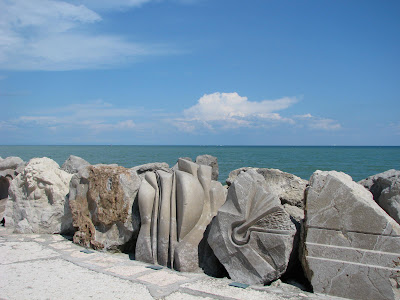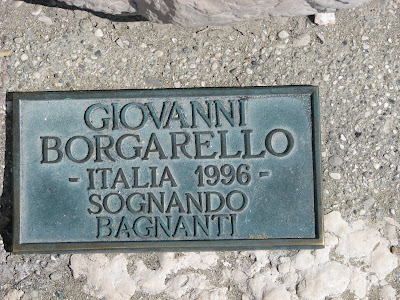Rather than “two gentlemen in fair Verona”, we were two Pennsylvanians by way of Pordenone in Verona. And while Verona is certainly a fair city, the weather on this day ran a bit afoul in the afternoon. However, for the first part of our journey, the sun was shining and the threat of rain clouds were not near enough to warrant lugging an umbrella around with us. (And there may have been the reason for rain --- if we carry an umbrella, it doesn’t rain; if we don’t, it does.)
Verona has elements that span centuries --- from the Roman arena , middle age buildings and architecture, and of course modern structures. The latter I find jars the eye when I want to only see “olde.”

Verona is somewhat of a “walled” city, part of the remnants you can see from where we parked our car. There is the remains of a stone wall, behind which is a huge earthen wall that is now used as a park area.


There are numerous squares of little parks. This one we passed was cool gathering spot for people to sit or await the bus.

Ahead were the “gates” of the old part of the city


Which when you passed through, on the right was the municipal building

the site this day of numerous weddings.

We saw at least two brides come out. In Italy a legal government ceremony has to take place first. For religious purposes this can be followed by a church wedding.
In front of the municipal building was Piazza Bra, a nice oasis with a fountain surrounded by shops on one side and the Roman arena on another. We ran into a few “characters” outside the arena.



Notice in the latter picture, where the lady has removed her hat and mask, there is a golden Egyptian “statue.” As you can probably tell, it was a hot day, so being in these costumes must have been brutal. In fact I spotted the Egyptian latter, standing in another part of town. This time in the shade of a building. I hope this character had a fan under that outfit!
The arena has been the site of the Verona summer opera season since 1913. The first production, Aida, is set for next weekend. Here are some shots of the arena and workers preparing the stage.













Some views of the town from atop the arena.







Here are a couple of pictures of Aida we took from a display inside the arena. Every few years whoever is directing it, wants to make it different, to make his own mark, so to speak. For a few years they did a “blue” Aida with minimal scenery. (I prefer the more traditional.)


A look inside the arena.

Driving in these old towns can be a nightmare with the narrow streets. And parking is nigh to impossible sometimes, so we opted to take a bus tour of the city. We chose to sit on the top of a double decked bus for the best views, but when it started to rain --- we got wet!




















The bus took us up on a hill overlooking the city, which to me, made the whole tour worthwhile, because we’d never have known to drive there ourselves. You can tell from the high, muddy river that there had been a bad storm “upriver.”












A funny thing happened on our bus tour, which we don’t have a picture of as David was a participant. This was the “maiden voyage” for this tour and assumedly they had navigated the streets with the bus before on a trial run. However, you can never predict how other cars will be parked, and when we encountered two on opposite sides of the street, parked too far into the street, we came to an impasse. Of course the owners were no where to be found, so what to do? There weren’t enough able or willing men to lift the cars, so they “bounced” them closer to the curb!
Since we were already quite damp, we opted to disembark at the next-to-last stop and walk to Juliet’s house. Along the way we encountered this archeological dig in the middle of the street.


Juliet’s house has become a mecca for all kinds of visitors, especially the young, who for some reason feel the need to leave their own mark. This archway located in the wall along the sidewalk leads you to a small courtyard where you can see the famous balcony. On the outside of the archway, on the walls on either side into the archway, there is so much graffiti that words are layered on top of another.



Standing inside this small courtyard, you are surrounded by walls.

The famous balcony, on the second floor.


the third floor

Some details that caught my eye. Notice more graffiti on the one.





We walked back to the car and enjoyed a flask of tea and cookies we had packed, and then drove to Giardia Giusti, which is located in town, but nicely tucked behind a building. You enter through the open doorway, which you can see in the picture. Notice the street right outside the door and the closeness of the building across the street.


But once you enter through that portal, paradiso: quiet, birdsong, burbling fountains. Here are some of the details of the courtyard.




Even some of the soffits are decorated.

The rear “wall” of the courtyard.




The garden stretches behind the courtyard, climbs the terraced hillside and is even “carved” into the rocky hillside. This is the view straight ahead as you enter the garden.


On either side of this main path, there are parterre gardens, a fountain AND a maze! I know there are a lot of pictures here, so if you aren’t into gardens, just skip ahead. But I thought every vista was beautiful.










On the way up the hill, there were ruins


and caves complete with stalactites.







We climbed this tower for a view below.




Coming back down we walked under this lovely arbor


along this wall



meeting some fellows along the way.



Isn’t this a magnificent specimen of a tree?

Some flora








I love this picture of the garden, which to me is the essence of a formal Italian garden: cypress trees, parterres, statuary and potted lemon trees.















































































































































































